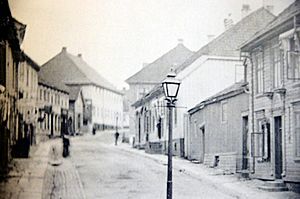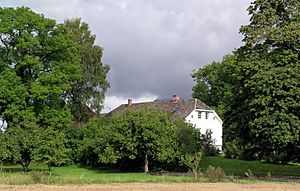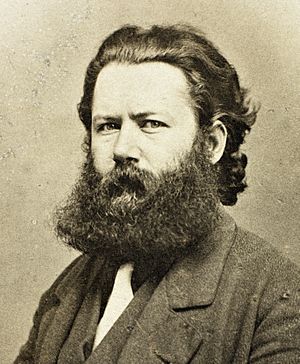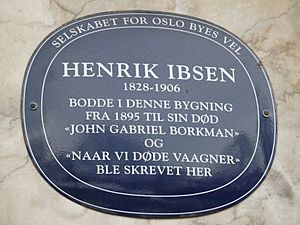Henrik Ibsen facts for kids
Quick facts for kids
Henrik Ibsen
|
|
|---|---|
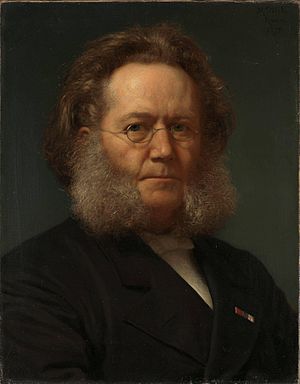
Portrait by Henrik Olrik, 1879
|
|
| Born | Henrik Johan Ibsen 20 March 1828 Skien, Telemark, Norway |
| Died | 23 May 1906 (aged 78) Kristiania, Norway (modern Oslo) |
| Occupation | Writer, playwright |
| Genres | Naturalism |
| Notable works | Brand (1865) Peer Gynt (1867) A Doll's House (1879) Ghosts (1881) An Enemy of the People (1882) The Wild Duck (1884) Rosmersholm (1886) Hedda Gabler (1890) |
| Spouse | Suzannah Thoresen (m. 1858) |
| Children | Sigurd Ibsen |
| Relatives | Knud Ibsen (father) Marichen Altenburg (mother) |
| Signature | |
Henrik Johan Ibsen (born March 20, 1828 – died May 23, 1906) was a famous Norwegian playwright and theatre director. He is known as "the father of realism" in theatre. This means he showed life as it really was, not just as a fantasy. He was one of the most important playwrights of his time.
Ibsen's plays are still performed a lot around the world. Only Shakespeare has more plays performed. His play A Doll's House was the most performed play in the world in 2006. Some of his other famous works include Brand, Peer Gynt, and Hedda Gabler.
His early play, Peer Gynt, had some dream-like parts. But later, Ibsen started writing in a realistic style. Many of his plays were seen as shocking back then. European theatre usually showed perfect family life. Ibsen, however, showed the hidden truths and problems behind the scenes. He looked closely at how people lived and what was right or wrong.
Ibsen is considered one of the greatest playwrights in Europe. He greatly influenced other writers like George Bernard Shaw and James Joyce. He was even nominated for the Nobel Prize in Literature several times.
Ibsen wrote his plays in Danish, which was a common written language in Norway at the time. Most of his plays are set in Norway, often in places like Skien, where he grew up. However, he lived for 27 years in Italy and Germany. He didn't visit Norway much during his most creative years. His plays often reflected his own background from a wealthy merchant family. He sometimes based characters on his own family members. His son, Sigurd Ibsen, later became a Prime Minister.
Contents
Henrik Ibsen's Early Life and Family Background
Where Did Henrik Ibsen Grow Up?
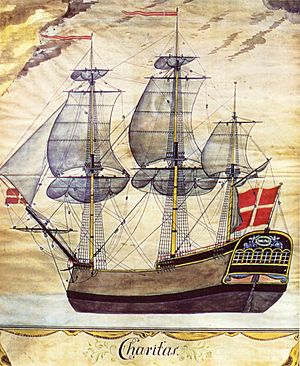
Henrik Johan Ibsen was born on March 20, 1828. He came from a rich merchant family in Skien, a busy port town in Norway. His parents were Knud Plesner Ibsen and Marichen Cornelia Martine Altenburg. Both of his parents came from important families in the city.
Ibsen's family members were mostly merchants and shipowners. Some were also important government officials. Henrik Ibsen once wrote that his parents belonged to "the most respected families in Skien." He said he was related to almost all the important families there.
What Was Ibsen's Family Like?
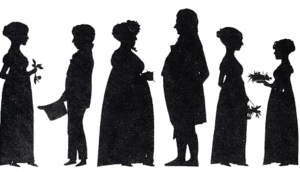
Henrik's parents were not closely related by blood. But they grew up almost like siblings in the same social circle. Knud Ibsen's father died at sea when Knud was a baby. His mother then married Ole Paus, a shipowner. Knud grew up with the Paus family.
Marichen grew up in a large, grand house called Altenburggården in Skien. Her father was a rich merchant who owned ships and a timber business. After her father died, her mother took over the businesses. During Henrik's childhood, the Paus and Altenburg families were very close. The children, including Knud and Marichen, spent a lot of time together.
In 1825, Henrik's father, Knud, started his own business. He sold timber and luxury goods with his younger half-brother, Christopher. They lived in a building called Stockmanngården. In 1825, Knud married Marichen, and they moved in together. Henrik was born there in 1828. In 1831, Marichen's mother gave her properties to Knud. The Ibsen family then moved into Marichen's childhood home, Altenburggården. Knud was a wealthy merchant in Skien during the 1820s and 1830s.
When Henrik was about seven years old, his father's business faced problems. In 1835, they had to sell Altenburggården. The next year, they moved to their large summer house, Venstøp, outside the city. They still had servants and socialized with other important families. In 1843, after Henrik left home, his family moved to a smaller house. Knud continued to struggle with his business. By the 1850s, he relied on his successful younger half-brothers for support.
How Did His Childhood Influence His Plays?
Many experts believe that Ibsen's plays were influenced by his family and childhood. His stories often deal with money problems and moral conflicts. These conflicts come from dark secrets that families try to hide. Ibsen himself said that he based characters in his plays on his own family.
Henrik Ibsen's Early Career as a Writer
Starting Out in Grimstad
When Ibsen was fifteen, he left school. He moved to a small town called Grimstad to become a pharmacist's helper. This is where he started writing plays. He later moved to Christiania (now Oslo) to go to university. But he soon decided to focus only on writing.
His first play, Catilina (1850), was published when he was 22. He used the pen name "Brynjolf Bjarme." But this play was never performed. His first play to be shown on stage was The Burial Mound (1850), but it didn't get much attention. Even so, Ibsen was determined to be a playwright.
Ibsen as a Theatre Director
Ibsen then worked at Det norske Theater (Bergen) for several years. He helped produce over 145 plays as a writer, director, and producer. During this time, he wrote five new plays, but they weren't very popular. Even though he wasn't famous yet, he gained a lot of useful experience in the theatre.
In 1858, Ibsen returned to Christiania to become the creative director of the Christiania Theatre. He married Suzannah Thoresen in June 1858. Their only child, Sigurd, was born in December 1859. The family faced money problems, and Ibsen became unhappy with life in Norway.
Henrik Ibsen's Years Living Abroad
In 1862, Ibsen left Christiania and moved to Sorrento, Italy. He chose to live outside Norway for 27 years. During this time, he only visited Norway a few times.
His next play, Brand (1865), finally brought him the praise he wanted. It also brought him some money. His next play, Peer Gynt (1867), was also very successful. The famous composer Edvard Grieg wrote music for Peer Gynt.
With this success, Ibsen became more confident. He started putting more of his own ideas into his plays. He called this the "drama of ideas." The plays he wrote next are often called his Golden Age. During this time, he became very powerful and influential. His plays caused a lot of discussion across Europe.
In 1868, Ibsen moved from Italy to Dresden, Germany. There, he spent years writing Emperor and Galilean (1873). He thought this play was his most important work. However, most people didn't agree. His later plays became much more famous. In 1875, Ibsen moved to Munich. He then started writing his first realistic play about modern life, The Pillars of Society (1877).
What is A Doll's House About?
A Doll's House came out in 1879. This play strongly criticized the traditional roles of husbands and wives in Ibsen's society. Ibsen was already in his fifties when A Doll's House was published. He saw his later plays as a series. He said they started with A Doll's House and ended with When We Dead Awaken. A Doll's House was the play that made Ibsen famous around the world.
What is An Enemy of the People About?
In An Enemy of the People, Ibsen focused on a big controversy. The main character, a doctor, finds that the public baths in his town are polluted. He expects to be a hero for saving the town. But instead, the townspeople call him an "enemy of the people." They turn against him and even throw stones at his house. The play shows how one person can be right, even if everyone else disagrees. It also shows how people can be selfish, no matter their beliefs.
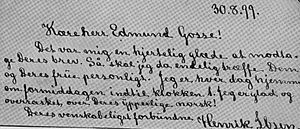
Ibsen's next play, The Wild Duck (1884), also challenged common ideas. But this time, it was about people who were too eager to change things. Many people think The Wild Duck is one of Ibsen's best and most complex works. It tells the story of Gregers Werle, who wants to reveal the "absolute truth." But he learns that sometimes the truth can be too hard for people to handle.
Later in his career, Ibsen wrote more about individual problems. Plays like Hedda Gabler (1890) and The Master Builder (1892) explored deep psychological conflicts. These plays are still very popular today. The role of Hedda Gabler is considered one of the most challenging for an actress.
Ibsen completely changed the rules of drama with his realistic style. Other playwrights like Chekhov followed his lead. From Ibsen's time onward, plays that challenge ideas and talk directly about important issues are seen as art. His works became known to English-speaking audiences thanks to William Archer and Edmund Gosse. Ibsen returned to Norway in 1891. He had played a big part in the changes that had happened in Norwegian society.
Henrik Ibsen's Death and Legacy
Henrik Ibsen died on May 23, 1906, in his home in Kristiania (now Oslo). He had suffered several strokes. He was buried in Vår Frelsers gravlund (The Graveyard of Our Savior) in central Oslo.
Celebrating Ibsen's Life
The year 2006 marked 100 years since Ibsen's death. Norway and other countries celebrated with an "Ibsen year." A TV miniseries about Ibsen's childhood was made. Many awards are given in his name, like the International Ibsen Award.
In 2006, the Ibsen Museum in Oslo reopened. It was the house where Ibsen spent his last eleven years. It was fully restored to look as it did when he lived there.
Ibsen's Lasting Impact
Ibsen's plays dealt with social issues of his time. But what makes his writing still powerful today are the psychological issues he explored. Even though the settings of his plays are from the 19th century, his insights into human nature are timeless.
Every year since 2008, the "Delhi Ibsen Festival" is held in Delhi, India. Artists from around the world perform Ibsen's plays in different languages and styles.
The Ibsen Society of America (ISA) was started in 1978. Its goal is to help people understand Ibsen's works. They do this through talks, readings, performances, and publications.
Henrik Ibsen's Family Tree
Henrik Ibsen and Suzannah Thoresen had one son, Sigurd Ibsen. Sigurd became a lawyer and a government minister, and even a Prime Minister of Norway. Sigurd Ibsen married Bergljot Bjørnson. Their son, Tancred Ibsen, became a film director. Sigurd Ibsen's daughter, Irene Ibsen, married into a Danish noble family.
Awards and Recognition for Henrik Ibsen
Ibsen received many honors during his life. He was made a Knight in 1873 and later received the Grand Cross of the Order of St. Olav in 1893. He also received high honors from Denmark and Sweden.
Many famous theatre directors in Austria and Germany performed Ibsen's works. In 1995, an asteroid was named 5696 Ibsen in his memory. In 2011 and 2012, artist Håkon Anton Fagerås created busts and a statue of Ibsen. These are in Sorrento, Skien, and the Ibsen Museum in Oslo.
Henrik Ibsen's Works
Plays by Henrik Ibsen
Plays that are partly or fully in verse are marked with a small 'v'.
- 1850 Catiline (Catilina)v
- 1850 The Burial Mound (Kjæmpehøjen)v
- 1852 St. John's Eve (Sancthansnatten)v
- 1854 Lady Inger of Oestraat (Fru Inger til Østeraad)
- 1855 The Feast at Solhaug (Gildet paa Solhaug)v
- 1856 Olaf Liljekrans (Olaf Liljekrans)v
- 1858 The Vikings at Helgeland (Hærmændene paa Helgeland)
- 1862 Love's Comedy (Kjærlighedens Komedie)v
- 1863 The Pretenders (Kongs-Emnerne)v
- 1866 Brand (Brand)v
- 1867 Peer Gynt (Peer Gynt)v
- 1869 The League of Youth (De unges Forbund)
- 1873 Emperor and Galilean (Kejser og Galilæer)
- 1877 Pillars of Society (Samfundets Støtter)
- 1879 A Doll's House (Et Dukkehjem)
- 1881 Ghosts (Gengangere)
- 1882 An Enemy of the People (En Folkefiende)
- 1884 The Wild Duck (Vildanden)
- 1886 Rosmersholm (Rosmersholm)
- 1888 The Lady from the Sea (Fruen fra Havet)
- 1890 Hedda Gabler (Hedda Gabler)
- 1892 The Master Builder (Bygmester Solness)
- 1894 Little Eyolf (Lille Eyolf)
- 1896 John Gabriel Borkman (John Gabriel Borkman)
- 1899 When We Dead Awaken (Når vi døde vaagner)
Other Writings by Ibsen
- 1851 Norma or a Politician's Love (Norma eller en Politikers Kjaerlighed), a short political parody.
- 1871 Digte – his only collection of poems, which included Terje Vigen.
Images for kids
See also
 In Spanish: Henrik Ibsen para niños
In Spanish: Henrik Ibsen para niños
- Centre for Ibsen Studies
- Ibsen Studies
- Norwegian Ibsen Award
- Naturalism (theatre)
- Nineteenth-century theatre
- Problem play


